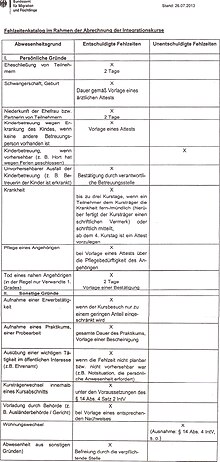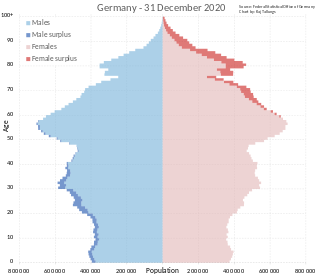
The demography of Germany is monitored by the Statistisches Bundesamt. According to the most recent data, Germany's population is 84,079,811 making it the most populous country in the European Union and the nineteenth-most populous country in the world. The total fertility rate was rated at 1.58 in 2021, significantly below the replacement rate of 2.1. For a long time Germany had one of the world's lowest fertility rates of around 1.3 to 1.4, however there has been a small increase in recent years. Due to the low birth rate Germany has recorded more deaths than births every year since 1972, which means 2021 was the 50th consecutive year the German population would have decreased without immigration. However, due to immigration the population has actually increased during the last half-century. In 2019 the number of people with a foreign background was 26%; this category includes foreigners, naturalized citizens, ethnic German repatriates from Eastern Europe and the children of all of the above.
Cross-cultural communication is a field of study that looks at how people from differing cultural backgrounds communicate, in similar and different ways among themselves, and how they endeavor to communicate across cultures. Intercultural communication is a related field of study.

In education, a curriculum is broadly defined as the totality of student experiences that occur in the educational process. The term often refers specifically to a planned sequence of instruction, or to a view of the student's experiences in terms of the educator's or school's instructional goals. A curriculum may incorporate the planned interaction of pupils with instructional content, materials, resources, and processes for evaluating the attainment of educational objectives. Curricula are split into several categories: the explicit, the implicit, the excluded, and the extracurricular.
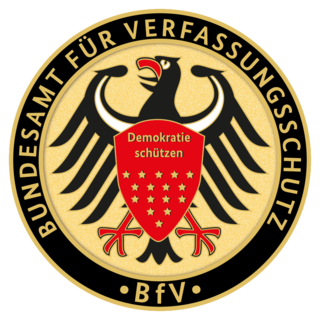
The Federal Office for the Protection of the Constitution is Germany's federal domestic intelligence agency. Together with the Landesämter für Verfassungsschutz (LfV) at the state level, the federal agency is tasked with intelligence-gathering on efforts against the liberal democratic basic order, the existence and security of the federation or one of its states, and the peaceful coexistence of peoples; with counter-intelligence; and with protective security and counter-sabotage. The BfV reports to the Federal Ministry of the Interior and tasks and powers are regulated in the Bundesverfassungsschutzgesetz. The President is Thomas Haldenwang; he was appointed in 2018.
Immigration to Germany, both in the country's modern borders and the many political entities that preceded it, has occurred throughout the country's history. Today, Germany is one of the most popular destinations for immigrants in the world, with well over 1 million people moving there each year since 2013. As of 2019, around 13.7 million people living in Germany, or about 17% of the population, are first-generation immigrants.

Intercultural learning is an area of research, study and application of knowledge about different cultures, their differences and similarities. On the one hand, it includes a theoretical and academic approach. On the other hand, it comprises practical applications such as learning to negotiate with people from different cultures, living with people from different cultures, living in a different culture and the prospect of peace between different cultures.
Cultural competence, also known as intercultural competence, is a range of cognitive, affective, and behavioural skills that lead to effective and appropriate communication with people of other cultures. Intercultural or cross-cultural education are terms used for the training to achieve cultural competence.
Hans T. Blokland is a Dutch social and political theorist.He was a fellow of the Royal Netherlands Academy of the Arts and Sciences and held visiting positions at Yale University and the University ofManchester. Between 2009 and 2015 Blokland was International Professor at the Humboldt University of Berlin. In 2012 he was also appointed on the Corelio-Chair for Media and Democracy at the Free University Brussels. And in 2013 he was appointed on the Alfred Grosser-Chair in sociology of the SciencesPo in France.
Tandem language learning is a method of language learning based on mutual language exchange between tandem partners, where ideally each learner is a native speaker in the language the other person wants to learn. The tandem language learning experience steps away from the traditional learning pedagogy, removing the teacher-student model. Many language schools in the world, organized as TANDEM International, as well as many universities, implement this approach.
Intercultural communicative competence in computer-supported collaborative learning is the application of computer-supported collaborative learning (CSCL) to provide intercultural communicative competence (ICC) to its users.
BAMF, or Bamf, may refer to:

About a quarter of a million German nationals had permanent residence in Switzerland in 2009, rising to some 300 thousand five years later. Accounting for multiple citizenships the number of German nationals living in Switzerlands is much higher, at about 450,000 in 2019. For the Germans, Switzerland became the most appreciated country to settle in, to find work or to study. The "surge" of immigration during the first decade of the 21st century, especially the German one, is a result of the EU-15 opening and, for students, of the Bologna Process.
Citizenship education for new citizens is education intended to prepare noncitizens to become legally and socially accepted as citizens, and is carried out by a variety of governmental and non-governmental organizations (NGO).
Global citizenship education (GCED) is a form of civic learning that involves students' active participation in projects that address global issues of a social, political, economic, or environmental nature. The two main elements of GCE are 'global consciousness'; the moral or ethical aspect of global issues, and 'global competencies', or skills meant to enable learners to participate in changing and developing the world. The promotion of GCE was a response by governments and NGOs to the emergence of supranational institution, regional economic blocs, and the development of information and communications technologies. These have all resulted in the emergence of a more globally oriented and collaborative approach to education. GCE addresses themes such as peace and human rights, intercultural understanding, citizenship education, respect for diversity and tolerance, and inclusiveness.
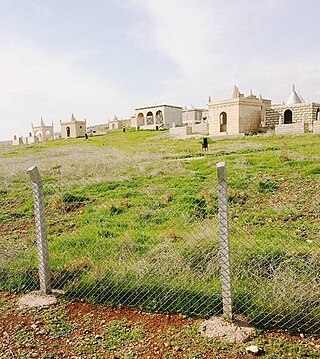
Yazidism in Turkey refers to adherents of Yazidism from Turkey, who remained in Turkey after the dissolution of the Ottoman Empire. The Yazidis living in Turkey during and after the second half of the 20th century gradually left for European countries. In the 1980s, there were 60,000 Yazidis situated in Beşiri, Kurtalan, Bismil, Midyat, Idil, Cizre, Nusaybin, Viranşehir, Suruç and Bozova. Today, these places are almost empty due to exodus to Europe which was provoked by political, religious and economic difficulties. Today only small number remain in villages around Midyat, Viranşehir, Çınar and Beşiri. According to the census of 2000, only 423 individuals adhering to Yazidism remained in the country.
The right of asylum for victims of political persecution is a basic right stipulated in the Constitution of Germany. In a wider sense, the right of asylum recognises the definition of 'refugee' as established in the 1951 Refugee Convention and is understood to protect asylum seekers from deportation and grant them certain protections under the law. Generally, these protections are a part of the asylum procedure itself and are verified by the Federal Office For Migration and Refugees without any further application.
The Bundesamt für Migration und Flüchtlinge is a German federal agency under the responsibility of the Federal Ministry of the Interior. It is located in the former Südkaserne in Nuremberg. It is the central migration authority in Germany and is responsible for registration, integration and repatriation of migrants. It carries out asylum proceedings and decides about asylum applications.
Agile learning generally refers to the transfer of agile methods of project work, especially Scrum, to learning processes. Likewise, agile learning proceeds in incremental steps and through an Iterative design which alternates between phases of learning and doing. The tutors rather have the role of a learning attendant or supporter. In a narrower sense, it is intended to allow competence-oriented, media-based learning in the work process within companies.
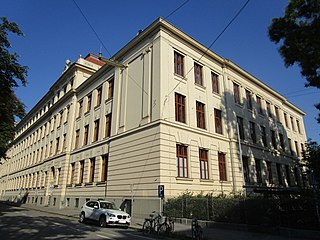
The University College of Teacher Education Styria is a teacher training university in Graz, Austria awarding undergraduate and master's degrees. It also operates continuing education programs.

Gonca Türkeli-Dehnert is a German administrative lawyer and government official in North Rhine-Westphalia.
